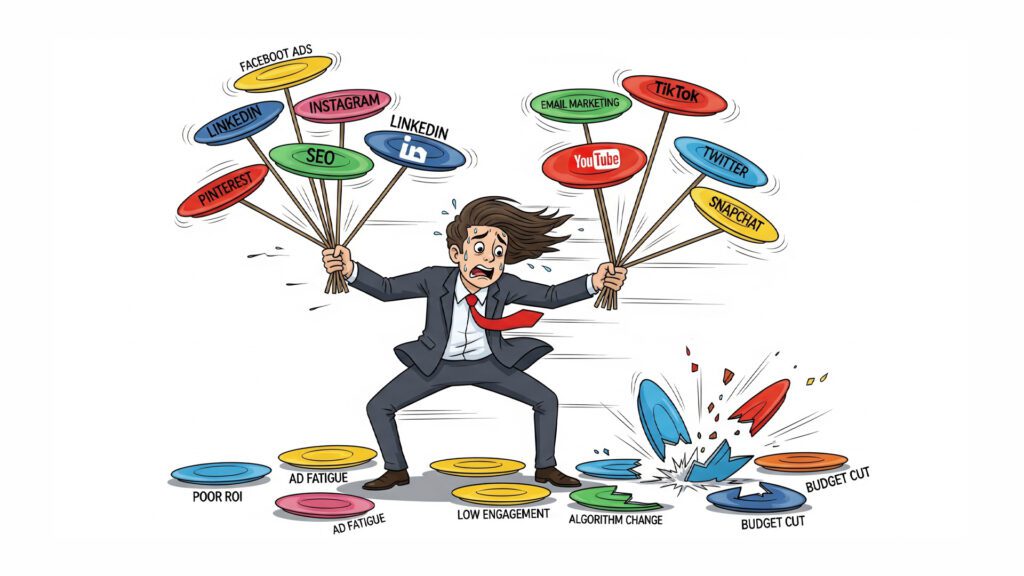“The ability to simplify means to eliminate the unnecessary so that the necessary may speak.”
– Hans Hofmann
Stop Drowning in Your Own Marketing Strategy
Picture this: It’s 2 AM, and you’re hunched over your laptop, squinting at a 47-page marketing plan that reads like a NASA launch manual. You’ve got seventeen different social media platforms to manage, twelve email sequences to optimize, and somewhere in the chaos, you’ve lost track of whether you’re supposed to be building a TikTok following or launching a podcast.
Sound familiar?
Welcome to the marketing overwhelm epidemic—where business owners have become digital plate-spinners, frantically trying to keep every marketing channel spinning while their actual business slowly suffocates under the weight of their own “comprehensive strategy.”
Here’s the kicker: Your marketing plan is probably killing your marketing results.
Why Your Complex Marketing Plan is Actually Sabotaging You
Let’s get brutally honest for a hot minute. That beautiful, color-coded, multi-platform marketing masterpiece sitting in your Google Drive? It’s not helping you. It’s hurting you.
Here’s why complex marketing plans fail faster than a paper airplane in a hurricane:
Decision fatigue is real, and it’s vicious. When you wake up to 47 different marketing tasks, your brain immediately goes into shutdown mode. Should you write that blog post, respond to Instagram comments, update your LinkedIn, or optimize your Facebook ads? By the time you’ve decided, it’s lunch time and you’ve accomplished exactly nothing.
Resource dilution is a silent killer. Trying to be everywhere means you’re nowhere effectively. You end up being that person who posts sporadically on eight platforms instead of dominating one or two.
Execution becomes impossible. Complex plans look impressive in meetings, but they crumble under real-world pressure. When life gets busy (and it always does), your 23-step marketing funnel becomes a 23-step nightmare.
The dirty little secret? Most marketing “experts” overcomplicate things because complexity feels impressive. But here’s what actually works: relentless focus on what moves the needle.
The One-Page Revolution: Why Less is Exponentially More
“The ability to simplify means to eliminate the unnecessary so that the necessary may speak.” – Hans Hofmann
What if I told you that every successful business has one thing in common? They do a few things incredibly well instead of doing everything mediocrely.
The one-page marketing plan isn’t about being lazy—it’s about being laser-focused. It’s about cutting through the noise and identifying the 20% of activities that drive 80% of your results.
Here’s the beautiful truth: Clarity creates momentum. When you can see your entire marketing strategy on one piece of paper, your brain can actually process it. You can spot gaps instantly, make decisions quickly, and—here’s the magic—you can actually execute it consistently.
Your One-Page Marketing Plan Blueprint
Ready to build yours? Grab a piece of paper (yes, actual paper) and let’s create something beautiful.
The Top Third: Your Foundation
Start with these three non-negotiables:
- Your One Perfect Customer Forget demographics and buyer personas that read like FBI profiles. Pick one real person. Give them a name. What keeps them awake at 3 AM? What makes them reach for their credit card? If you can’t describe your customer like you’re talking about your best friend, you’re still too vague.
- Your One Compelling Promise What’s the one thing you do that makes people say “Where have you been all my life?” Not three things. Not five things. One thing that makes you irreplaceable.
- Your One Big Goal Pick one number that matters. Revenue, new customers, email subscribers—whatever moves your business forward. Everything else is just noise.
The Middle Third: Your Strategy
Now for the meat and potatoes:
Your Primary Channel: This is your marketing home base. The place where you’ll invest 70% of your time and energy. Choose based on where your customers actually hang out, not where you think they should be.
Your Secondary Channel: This is your backup singer—important but not the star. Allocate 30% of your efforts here.
Your Content Themes: Pick 2-3 messages you’ll hammer home consistently. Repetition isn’t boring; it’s branding.
The Bottom Third: Your Execution
This is where dreams meet reality:
Weekly Actions: List 3-5 specific tasks you’ll do every single week. No exceptions, no excuses.
Monthly Checkpoints: Schedule time to review what’s working and what’s not.
Success Metrics: Choose 1-3 numbers you’ll track religiously.
The Magic Happens in What You DON’T Do
Here’s where most people mess up: they think the one-page plan means doing less work. Wrong. It means doing less types of work so you can do more of the right work.
Your one-page plan is like Marie Kondo for your marketing—if it doesn’t spark joy (or sales), it doesn’t belong.
The Elimination Rules:
- If it’s not on the page, you don’t do it
- If it doesn’t directly support your one big goal, it gets cut
- If you can’t do it consistently, it’s not sustainable
“It is not a daily increase, but a daily decrease. Hack away at the inessential.” – Bruce Lee
Real Results from Real Businesses
Sarah, a business coach, was posting on Instagram, LinkedIn, Twitter, Facebook, running Google Ads, doing webinars, and sending three different email newsletters. She was exhausted and her revenue was flat.
Her one-page plan? Focus on LinkedIn content and email marketing. That’s it.
Result? She doubled her client base in six months while working 15 fewer hours per week on marketing. Why? Because she finally got good at two things instead of being mediocre at eight.
Your Quick Start Action Plan
Today (5 minutes): Grab that overwhelming marketing plan and highlight only the activities that directly led to sales in the last 90 days. Everything else gets deleted.
This Week: Create your one-page plan using the blueprint above. Yes, it feels scary to let go of all those “might work” strategies. Do it anyway.
This Month: Execute only what’s on your page. Fight the urge to add “just one more thing.” Trust the process.
The Bottom Line
Your marketing plan should fit on one page because your customers’ attention spans definitely don’t exceed one page. If you can’t explain your marketing strategy in 60 seconds, it’s too complicated.
The goal isn’t to impress people with your comprehensive approach—it’s to get results with your focused execution.
Stop trying to be everywhere and start dominating somewhere. Your future self (and your stress levels) will thank you.
Ready to cut your marketing workload in half while doubling your results? Your one-page plan is waiting.









